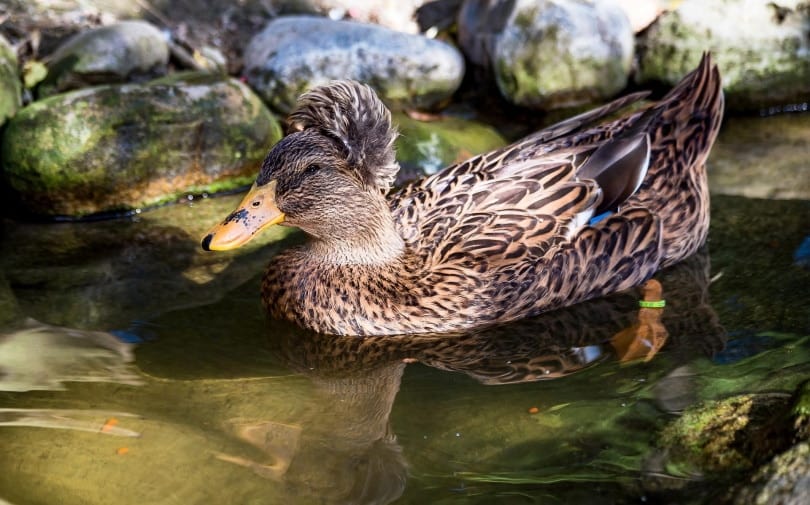The Crested Duck is certainly a multi-purpose duck! They are suitable for their eggs and meat, but they are also lovely pets and make wonderful ornamental birds.
They obtained their name due to their eye-catching headpiece. These ducks are known as Le Canard Huppe in Belgium and France but are believed to have originated in the Netherlands.
If you would like to learn more about these unique ducks, read on, as we get into everything about them, from their history to their appearance and other interesting facts and tidbits.

Quick Facts About the Crested Duck

| Breed Name: | Crested Duck |
| Place of Origin: | Netherlands |
| Uses: | Meat, eggs, pets |
| Drake (Male) Size: | About 7 pounds |
| Duck (Female) Size: | About 6 pounds |
| Colors: | White, black, gray Mallard, buff, blue |
| Lifespan: | 8–12 years |
| Climate Tolerance: | Most climates |
| Care Level: | Easy |
| Production: | Good egg and meat production |
Crested Duck Origins
Where and how the Crested Duck came about is relatively unknown, but it’s believed that they arrived in Europe by way of Dutch ships from the East Indies. They may have been around since the 1600s, as they were depicted in Dutch paintings, specifically, Jan Steen’s painting in 1650 entitled, “Poultry Yard.”
It’s possible that the Crested Duck was developed from Crested Runner Ducks, otherwise known as Bali Ducks, and local ducks from the East Indies.
The Crested Duck was introduced to the United States in the 1800s, and the White Crested Duck was admitted to the American Standard of Perfection in 1874. It took just over 100 years for the Black Crested to gain the same honor. They were accepted into the British Stand of Perfection in 1910.

Crested Duck Characteristics
Crested Ducks have lovely temperaments, and they tend to be quiet — for ducks, anyway. They are friendly, easy to care for, and tolerant of most climates. This duck has an average lifespan of about 8 to 12 years when well cared for.
Crested Ducks are not known for their flying abilities. They will use their wings to speed up their running, particularly if they’re trying to escape something. They also tend to not walk well; they simply totter along and are easily knocked over. Cresteds are much more graceful in the water.
The characteristic that gives these ducks their name is the tuft of feathers that adorn the tops of their heads. It’s actually a heterozygous trait (which means inheriting different forms of a specific gene from each parent) that is a mutation that causes a deformity in the duck’s skull.
This mutation creates a gap in the duck’s skull while it is an embryo, through which a mass of fatty tissue grows. From this mass of fatty tissue, feathers grow, which creates the weird yet adorable crest of feathers.

Uses
Crested Ducks were commonly kept as meat ducks because they have deep breasts. They’ve also been used for their eggs because they are good layers and are known to produce 120 to 200 eggs every year. The female duck lays an average of 9–13 eggs, and it takes about 28 days for the eggs to hatch.
However, Crested Ducks are much more commonly kept as pets and ornamental birds these days.
Appearance & Varieties
The most noteworthy aspect of the Crested Duck’s appearance is the poof of feathers on the crown of their head.
They are medium in size, and their body tends to stand fairly straight but at an angle, with a straight neck.
The most common colors of this duck are white and black, which also happen to be the only colors recognized by the American Poultry Association’s Standard of Perfection. Still, they also come in other colors, like buff, gray, and blue, as well as Mallard colors.
They have long legs, and the white ducks have beaks that are pale orange, and the black ducks have gray beaks.

Population/Distribution/Habitat
They are found around the world because they are hardy in most climates, and they are a relatively common breed. They typically need a duck coop or house and a body of water close by. Even a small pool can do the trick.
The coop will need bedding like straw or shavings, but remember to remove wet bedding, or it will become moldy. Most duck houses also need a ramp so they can come and go, and it needs to be weather and predator proof.
Are Crested Ducks Good for Small-Scale Farming?
Crested Ducks make excellent pets and will also do quite well in small-scale farming scenarios. They do well in captivity and when they are allowed to free range. They can effectively eliminate many large bugs from your backyard.
Crested Ducks are quiet and are not aggressive in any way. These friendly and unique-looking ducks make fantastic pets for most small and backyard farms.

Featured Image Credit: Lilly P. Green, Shutterstock
